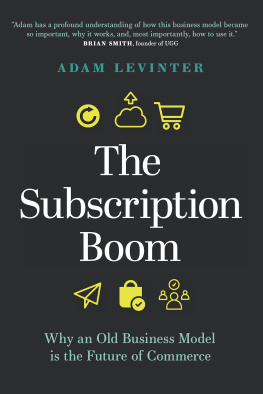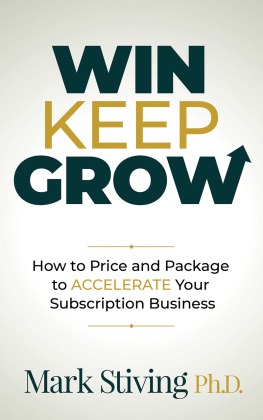Adam Levinter - The Subscription Boom
Here you can read online Adam Levinter - The Subscription Boom full text of the book (entire story) in english for free. Download pdf and epub, get meaning, cover and reviews about this ebook. year: 2019, publisher: Figure 1 Publishing, genre: Romance novel. Description of the work, (preface) as well as reviews are available. Best literature library LitArk.com created for fans of good reading and offers a wide selection of genres:
Romance novel
Science fiction
Adventure
Detective
Science
History
Home and family
Prose
Art
Politics
Computer
Non-fiction
Religion
Business
Children
Humor
Choose a favorite category and find really read worthwhile books. Enjoy immersion in the world of imagination, feel the emotions of the characters or learn something new for yourself, make an fascinating discovery.
- Book:The Subscription Boom
- Author:
- Publisher:Figure 1 Publishing
- Genre:
- Year:2019
- Rating:3 / 5
- Favourites:Add to favourites
- Your mark:
- 60
- 1
- 2
- 3
- 4
- 5
The Subscription Boom: summary, description and annotation
We offer to read an annotation, description, summary or preface (depends on what the author of the book "The Subscription Boom" wrote himself). If you haven't found the necessary information about the book — write in the comments, we will try to find it.
The Subscription Boom — read online for free the complete book (whole text) full work
Below is the text of the book, divided by pages. System saving the place of the last page read, allows you to conveniently read the book "The Subscription Boom" online for free, without having to search again every time where you left off. Put a bookmark, and you can go to the page where you finished reading at any time.
Font size:
Interval:
Bookmark:
It is March 6th 2012, 9 AM EST , and Dollar Shave Clubs web servers are unprepared for the surge of traffic about to descend on the California-based start-ups website. Michael Dubin, the companys founder, is scrambling, terrified, in his words, that, in that moment, my biggest dreams were turning into my worst nightmares.
The quirky yet brilliant video he produced to magnify the companys official launch has fierce momentum on YouTube, the play count increasing more rapidly with each passing minute. A half hour in, the website crashes. At Dollar Shave Clubs borrowed office space, a few individuals work frantically to get the overheated servers back online.
When the smoke clears a few hours later, the promotional video has crushed all expectations: millions of views, and 12,000 new Dollar Shave Club subscribers. ) before reading on, but heres a small sample of the script:
[Mike is sitting at his office desk. Close-up shot of head and shoulders. Childrens toys are hung up all over the background wall. Camera slowly zooms out as Mike begins to speak.]
Mike: Hi. Im Mikefounder of dollarshaveclub.com. What is dollarshaveclub.com? Well, for a dollar a month we send high-quality razors right to your door. [Mike stands up and begins moving around the desk towards the door.] Yeah. A dollar. Are the blades any good? No. [Stops in doorway and points at the poster to the right] Our blades are fucking great.
Known to industry colleagues as a brilliant marketer with a savvy entrepreneurial frugality, Dubin took a DIY approach to the video. He starred in it himself, and used his existing fulfillment warehouse as a set for his smug yet humorous delivery. In all, he produced and shot the video for only $ 4,500peanuts compared to what traditional ad agencies charge. As I write this, the one-and-a-half minute sliver of marketing genius has over 26 million views.
Dollar Shave Club, or DSC , as Dubin calls it, is an online company that sells razors and other mens personal grooming products by shipping them direct to consumers. Customers select a shave plan based on blade type, and subscribe for only a few dollars a month. The branding is slick, and framing the subscription as an opportunity to join a club puts a new spin on an old-school industry once dominated by legacy brands Gillette and Schick.
The barber shop aesthetic and irreverent humor might grab some initial attention, but that isnt enough to keep customers around long enough to build a billion-dollar business. The thing that really resonates for DSC subscribers is the same for most companies outlined in this book: a superior customer experience. That experience includes some obvious pieces, like great customer service, and convenience. But, ultimately, DSC used the subscription model as the business pillar to build enduring customer loyaltya necessary requirement for success in todays new age of consumerism.
Shopping, in the traditional sense, involves a buyer and a seller. A potential buyer learns about a product, usually from exposure to branded marketing, and if its compelling enough to buy, they do so via a store or website. Following the purchase, the buyers role shifts to that of a consumer (or user, if you prefer). If as a consumer, they are happy with the product, they might buy it again, or perhaps buy it for someone else; if not, they will likely try an alternative, and much of the initial marketing spend to move the buyer down the funnel from awareness and interest, to consideration, and, ultimately, to purchase wont amount to much profit over time.
Data geeks in corporate cubicles run spreadsheets and formulas attempting to dive deeper into this spectrum of consumer behavior, hoping to understand how to get buyers to make repeat purchasesand allow businesses to reap higher profits without constantly spending money to acquire new customers.
As brands claw at one another in an attempt to gain more market share, a new mode of retail commerce is on the rise, one largely driven by direct-to-customer brands generating repeat purchases via subscriptions. In recent years, the number of such businesses has grown significantly, from hundreds to thousands worldwide, prompting progressive thinkers to suggest that we are entering the age of the subscription-based economy.
Shifting to a subscription model fundamentally transforms how a company chooses to operate. While companies like Netflix, Spotify, IPSY , Amazon, and others may offer very different products and services, they are all pioneers in this changing world of digital commerce, where customers are being transformed from one-time purchasers into loyal subscribers. Spotify, the most successful music-streaming service globally, has over 200 million active monthly users, about half of whom are paid subscribers. Amazon Prime boasts over 100 million members. Netflix, the global leader in the world of video-on-demand, has garnered over 135 million subscribers across 190 countries since pivoting from its direct-mail DVD origins.
These sorts of consumer-oriented subscription businesses are seeing tremendous growth. Fueled by venture-capital investment, a plethora of start-ups have also launched and grown successful subscription money-makers in a wide range of categories, including food, personal care, baby, beauty, apparel, contact lenses, vitamins, and more.
IPSY , a cosmetics sample-box company that ships a Glam Bag to over 3 million subscribers each month, is widely considered to be one of the biggest subscription success stories to date. In 2015 the company was valued at $ 500 million, and recent reports suggest it could sell for as high as $ 2 billion.
After Dollar Shave Club released its hilarious viral marketing video, its subscription razors propelled the mens grooming space to new heights, knocking Gillette and Schick back on their heels and prompting other new entrants to launch similar offerings. The company grew its subscriber count to just shy of 4 million subscribers by 2018, even as it faced competition from copycats like Harrys.
Birchbox, IPSY s number one competitor, which sends samples of beauty products to its upmarket subscribers for about $ 15 each month, recently partnered with Walgreens to open stores-within-stores, a quick pivot from its own brick-and-mortar location in Soho. Stitch Fix curates a box of stylish fashion items which it sends directly to its dedicated customers, many of whom opt for recurring boxes, while UK -founded Graze ships monthly boxes of healthy snacks to its loyal followers. This kind of curation is a common theme across other subscription categories, such as food delivery, where meal kits, such as Plated and Blue Apron, send out recipes and all the necessary ingredients for a custom, cook-at-home experience.
Theres also plenty of momentum beyond these types of curated subscriptions. Access subscription is another model that, though it has long been ubiquitousin the form of gym memberships, country clubs, or online dating siteshas seen a resurgence. A new ramp-up of product-based companies like JustFab and Thrive Market are offering discounts on womens clothing and organic brands, respectively, to members only.
A growing number of subscription players now provide effort-less replenishment of everyday items, automating the purchase-and-delivery cycle of household staples such as diapers or laundry detergent. While Dollar Shave Club has mastered this subscription category with its razor offering, others, like Amazon, are operating similar business models. Subscribe and Save offers a 5 to 15 percent discount if consumers agree to regular deliveries of eligible goods like coffee and peanut butter. Jessica Albas Honest Company applies a similar methodology to its subscription plans on things like diapers and wipes.
Some legacy companies have also pivoted from one-time purchase models to recurring subscriptions, especially in the realm of software-as-a-service, or SaaS. Microsoft is growing its subscription-based Office 365 offering for small businesses. LinkedIn, now owned by Microsoft, has focused heavily on its monthly subscription offerings like Premium, Sales Navigator, and Recruiter Lite. And perhaps most notably, in 2013 Adobe Systems stopped selling licences to its Creative Suite software (Photoshop, InDesign, etc.) in a bid to move everything to a $ 50-per-month Creative Cloud subscription plan.
Font size:
Interval:
Bookmark:
Similar books «The Subscription Boom»
Look at similar books to The Subscription Boom. We have selected literature similar in name and meaning in the hope of providing readers with more options to find new, interesting, not yet read works.
Discussion, reviews of the book The Subscription Boom and just readers' own opinions. Leave your comments, write what you think about the work, its meaning or the main characters. Specify what exactly you liked and what you didn't like, and why you think so.










